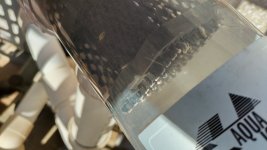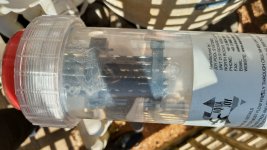Lifted from pool school :
How to Clean a SWG Cell
You should only clean a SWG cell if it has visible scale on the plates. Try and clean with the process that will do the least damage to the rare metal plates and then move to more aggressive methods if necessary.
Cleaning a SWG cell with Water
First try and use strong blasts of water to remove the scale. One mehmber found success using a WaterPik.
Cleaning a SWG cell by Scraping Plates
You can scrape the plates with a stick, like a Popsicle stick, to remove the scale.
Cleaning a SWG cell with Vingear Acetic Acid
If the scale is stubborn then use cleaning vinegar (6% acetic acid … available in Home Depot). It’s milder than Muriatic Acid and won’t damage the ruthenium surface. Highly concentrated mineral acids are not good for the transition metal catalysts.
Cleaning a SWG cell with Citric Acid
On a molar basis citric acid will be “stronger” than either acetic acid or ascorbic acid. So it will produce a solution with lower pH due to more acid protons (H+) being released. This is why your perception is that it works better on scale than vinegar does.
[5]
All acids will remove a small amount of material from the ruthenium surface because ruthenium oxide is not stable in acidic conditions. Ruthenium metal itself is highly reactive to air forming ruthenium oxide. In water, a pure ruthenium metal surface will slowly oxidize based on the amount of dissolved oxygen in the water as well as oxidation formed by hydrolysis. So, if you leave a chunk of ruthenium in highly acidic water for a long period of time, it will dissolve.
The key to cleaning calcium scale off the plates is to use an acid that is strong enough to destabilize the carbonate anion (force carbonate to become CO2) and remove the calcium without the acid also etching the ruthenium metal. The conjugate base of the acid matters as well. Chlorides and sulfates do increase the likelihood of reforming ruthenium oxides quickly enough at the ruthenium metal surface such that hydrochloric acid and sulfuric acid would be poor choices. Ascorbate ions from ascorbic acid tend to be anti-oxidants and will less likely increase the repassivation of the metal surface. Acetic acid creates acetate ions which also weakly interact with ruthenium. As far as citrate goes (the conjugate base of citric acid), I'm not entirely certain as I would have to search the literature for it. My guess is it will be more aggressive towards ruthenium than either ascorbic acid or acetic acid but much less aggressive than muriatic acid. Citrate tends to act as a chelating agents to many transitions metals like iron and cobalt so I would expect ruthenium to complex pretty readily with citrate given the many different stable oxidation states that a ruthenium atom can attain. Ascorbates and acetates are weaker chelating agents.
If you don't happen to have vinegar lying around, and the big bag of citric acid is just sitting there screaming to be used, then you can probably use it without much harm. There's really no need to make highly concentrated solutions. A few % in distilled water will very effectively soften or remove calcium scale. Then just hit it with a garden hose spray to flush it out.
Cleaning a SWG cell with Muriatic Acid
Cleaning a SWG cell with Muriatic Acid 10:1 diluted solution will remove some of the rare earth coating from the plates and reduce the life of the cell with every cleaning.



